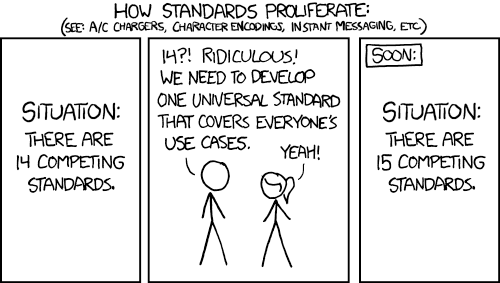When you run out of characters, you simply create another 0 byte file to encode the rest.
Check mate, storage manufacturers.

When you run out of characters, you simply create another 0 byte file to encode the rest.
Check mate, storage manufacturers.


Millenials - Load"$“,8 LIST LOAD"LEISURESUIT*”,8,1 (wait 10 min.) RUN
Even the oldest millennials were just toddlers when the C64 was relevant, so this is not a typical millennial experience at all. It’s really a GenX thing… so once again we are forgotten.
I would say millennials’ computer experience starts in the late DOS/Win3.11 era at the very earliest, but more typically in the Windows 9x and early XP era. So even IRQ/DMA/config.sys/autoexec.bat fuckery is not that typical.


Ctrl + r to search previous commands
That’s a readline thing by the way, so it doesn’t just work in bash but also works with other cli applications that are compiled with readline support, for example virsh, psql, fdisk, …
I’ve honestly never understood why someone at Google or Mozilla hasn’t decided to write a JavaScript Standard Library.



How is that not enough? It’s in standard ISO8601 format and can unambiguously be reduced to a UTC timestamp, which is all that matters.


We are talking about addresses, not counters. An inherently hierarchical one at that. If you don’t use the bits you are actually wasting them.
Bullshit.
I have a 64-bit computer, it can address up to 18.4 exabytes, but my computer only has 32GB, so I will never use the vast majority that address space. Am I “wasting” it?
All the 128 bits are used in IPv6. ;)
Yes they are all “used” but you don’t need them. We are not using 2^128 ip addresses in the world. In your own terminology: you are using 4 registers for a 2 register problem. That is much more wasteful in terms of hardware than using 40 bits to represent an ip address and wasting 24 bits.


you are wasting 24 bits of a 64-bit register
You’re not “wasting” them if you just don’t need the extra bits, Are you wasting a 32-bit integer if your program only ever counts up to 1000000?
Even so when you do start to need them, you can gradually make the other bits available in the form of more octets. Like you can just define it as a.b.c.d.e = 0.a.b.c.d.e = 0.0.a.b.c.d.e = 0.0.0.a.b.c.d.e
Recall that IPv6 came out just a year before the Nintendo 64
If you’re worried about wasting registers it makes even less sense to switch from a 32-bit addressing space to a 128-bit one in one go.
Anyway, your explanation is a perfect example of “second system effect” at work. You get all caught up in the mistakes of the first system, in casu the lack of addressing bits, and then you go all out to correct those mistakes for your second system, giving it all the bits humanity could ever need before the heat death of the universe, while ignoring the real world implications of your choices. And now you are surprised that nobody wants to use your 128-bit abomination.


IPv6 = second system effect. It’s way too complicated for what was needed and this complexity hinders its adoption. We don’t need 100 ip addresses for every atom on the earth’s surface and we never will.
They should have just added an octet to IPv4 and be done with it.


At 17:00 everyone’s got a beer on their desk and by 18:00 the doors are locked and the lights are out. One Thursday a month the table is used for beer pong after work and we play card games like Exploding Kittens.
I’d rather go home at 17:00 and do all those things with my real friends, or you know, spend some quality time with my partner.


You don’t even have to NAT the fuck out of your network. NAT is usually only needed in one place: where your internal network meets the outside world, and it provides a clean separation between the two as well, which I like.
For most internal networks there really are no advantages to moving to IPv6 other than bragging rights.
The more I think about it, the more I find IPv6 a huge overly complicated mistake. For the issue they wanted to solve, worldwide public IP shortage, they could have just added an octet to IPv4 to multiply the number of available addresses with 256 and called it a day. Not every square cm of the planet needs a public IP.


It’s when you have to set static routes and such.
For example I have a couple of locations tied together with a Wireguard site-to-site VPN, each with several subnets. I had to write wg config files and set static routes with hardcoded subnets and IP addresses. Writing the wg config files and getting it working was already a bit daunting with IPv4, because I was also wrapping my head around wireguard concepts at the same time. It would have been so much worse to debug with IPv6 unreadable subnet names.
Network ACLs and firewall rules are another thing where you have to work with raw IPv6 addresses. For example: let’s say you have a Samba share or proxy server that you only want to be accessible from one specific subnet, you have to use IPv6 addresses. You can’t solve that with DNS names.
Anyway my point is: the idea that you can simply avoid IPv6’s complexity by using DNS names is just wrong.


You do need to know it when you’re working with subnets and routing tables.
Unless you have anything but a flat network structure with everything in one subnet, working with IPV6 is a giant PITA.


It’s a documentary.




Yeah god forbid people have some interesting discussion on this platform, right?


The post doesn’t answer the questions, it’s why I asked.
It says:
All running on a krun microVM with FEX and full TSO support 💪
I was not expecting Party Animals to run! That’s a DX11 game, running with the classic WineD3D on our OpenGL 4.6 driver!
Now I know some of these words, but it does not answer my question.


So how does that work given that most Steam games are x86/x64 and the M2 is an ARM processor? Does it emulate an x86 CPU? Isn’t that slow, given that it’s an entirely different architecture, or is there some kind of secret sauce?
I ran it perfectly on a 33MHz 486 with 4mb RAM for a long time. Even Doom II with some of its heavier maps ran fine.
“Perfectly” would mean it ran at 35fps, the maximum framerate DOS Doom is capped at. In the standard Doom benchmark, a dx33 gets about half that: 18fps average in demo3 of the shareware version with the window size reduced 1 step. Demo3 runs on E1M7, which isn’t the heaviest map, so heavier maps would bog the dx33 down even more.
I’m sure you found that acceptable at the time, and that you look back on it with slightly rose-tinted glasses of nostalgia, but a dx2/66 and preferably even better definitely gave you a much better experience, which was my point.
If anyone can enlighten me, This is pretty much why you can find DooM on almost any platform BECAUSE of its Linux code port roots?
I mean yeah. Doom was extremely popular and had a huge cultural impact in the 90s. It was also the first game of that magnitude of which the source was freely released. So naturally people tried to port it to everything, and “but can it run Doom?” became a meme on its own.
It also helps that the system requirements are very modest by today’s standards.
You can give me any file, and I can create a compression algorithm that reduces it to 1 bit. (*)
spoiler
(*) No guarantees about the size of the decompression algorithm or its efficacy on other files